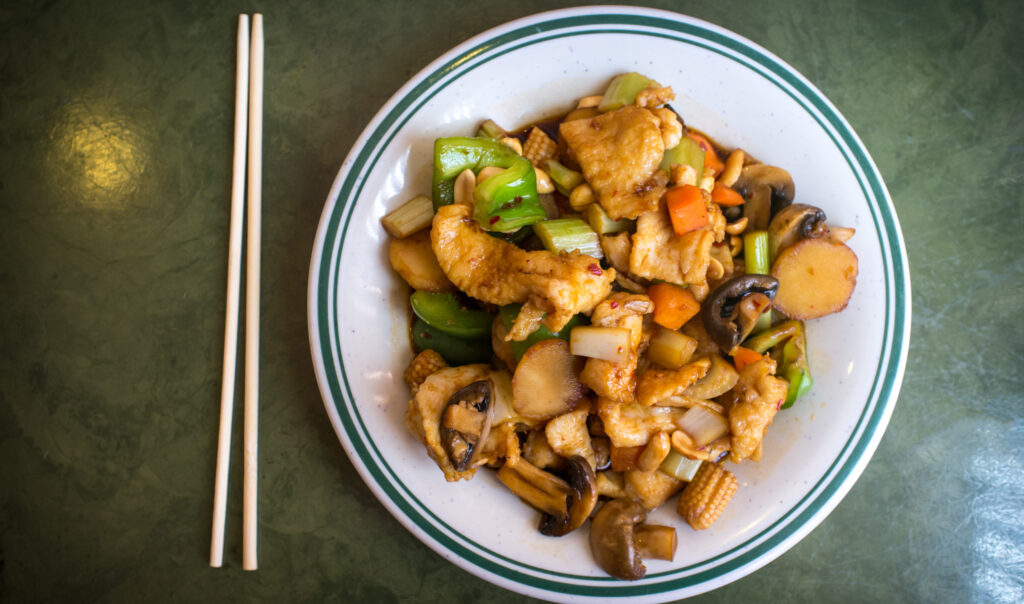Kung Pao Chicken, a hallmark of Chinese cuisine, is renowned for its tantalizing balance of sweet, sour, and spicy flavors.
This dish is an exhilarating culinary journey for your taste buds, offering a symphony of textures from the tender chicken to the crunchy peanuts.

Whether you’re a novice or a seasoned cook, this recipe is designed to be moderately easy, ensuring a delightful cooking experience.
Kung Pao Chicken Recipe
Prep and Cooking Time:
- Preparation time: 20 minutes
- Cooking time: 10 minutes
- Total time: 30 minutes
- Servings: 4
Authentic Ingredients for Kung Pao Chicken:
- Chicken breast (500g or 17.6 ounces), cut into slices or bite-size pieces
- Cornstarch (30g or 1 ounce), for coating
- Soy sauce (60ml or 2 ounces)
- Shaoxing wine ↓ (30ml or 1 ounce)
- Sesame oil (15ml or 0.5 ounce)
- Vegetable oil (60ml or 2 ounces), for stir-frying
- Dried red chilies (15g or 0.5 ounce), chopped
- Sichuan peppercorns (5g or 0.2 ounce)
- Garlic (15g or 0.5 ounce), minced
- Ginger (15g or 0.5 ounce), minced
- Spring onions (30g or 1 ounce), chopped
- Roasted peanuts (60g or 2.1 ounces)
- Sugar (10g or 0.35 ounce)
- Vinegar (15ml or 0.5 ounce)
Also see Optional Ingredients ↓ that I often add to my recipe.
Prep & Cooking:
- Marinate the chicken pieces in a mixture of soy sauce, Shaoxing wine, and cornstarch. Set aside for 15 minutes.
- Heat vegetable oil in a wok over high heat. Add the Sichuan peppercorns and dried chilies, frying until fragrant.
- Add the marinated chicken to the wok and stir-fry until it’s nearly cooked through.
- Add the garlic, ginger, and spring onions, stir-frying for another minute.
- Stir in the sugar, sesame oil, and vinegar, mixing well.
- Finally, add the roasted peanuts, toss everything together, and cook for an additional 2 minutes.
How Spicy is this recipe of Kung Pao Chicken?
The spiciness of the Kung Pao Chicken recipe, as provided, can be considered moderately spicy.
It’s designed to offer a balanced heat that complements the other flavors without overpowering them. The key contributors to the spiciness in this recipe are the dried red chilies and Sichuan peppercorns.
- Dried Red Chilies: These add a direct, sharp heat. The number and type of chilies used can greatly influence the overall spiciness. You can adjust the amount to suit your taste. Using fewer chilies or removing the seeds can reduce the heat.
- Sichuan Peppercorns: These are known for their unique aroma and a tingling, numbing sensation rather than outright heat. The quantity of Sichuan peppercorns can be adjusted to modify this aspect of the dish’s spiciness.
Remember, everyone’s tolerance for spice varies. If you’re sensitive to spicy foods, you might find the dish quite hot.
For example, if you prefer a milder version, reducing the quantities of both chilies and Sichuan peppercorns will lower the spiciness without significantly altering the fundamental flavors of the dish.
Conversely, if you enjoy spicy foods, you might find the level of heat in this recipe to be mild and may want to increase the amount of chilies and peppercorns.
Tips for Perfection:
- Use high heat for a quick stir-fry to keep the chicken tender.
- Marinate the chicken well to enhance the flavor.
- Adjust the number of chilies and Sichuan peppercorns to suit your spice tolerance.
Optional Ingredients:
I often add:
- Water Chestnuts
- Baby Corn
- Mushrooms (halved)
- Red onion (chopped)
- Celery (sliced)
- Carrots (diced)
- Bell peppers (thick chopped)
.
You could also add: - Zucchini (sliced)
- Cashews instead of peanuts
Vegetarian Suggestions:
Replace chicken with the mushrooms, firm tofu, or tempeh, following the same marinating and cooking process.
Serving Suggestions:
Serve alone, or with steamed rice, or noodles.
About Shaoxing Wine
Shaoxing wine is a traditional Chinese rice wine originating from the region around Shaoxing in Zhejiang province, China.
It’s made from fermented rice and is a key ingredient in Chinese cooking, widely used to enhance the flavors of many dishes.
In terms of taste, Shaoxing wine has a complex profile. It is slightly sweet, with a rich and nutty flavor that is often compared to sherry.
The wine also possesses a subtle savory taste, which can be described as umami, making it a great addition to both meat and vegetable dishes.
The aging process of the wine can influence its flavor, with older varieties typically having a more pronounced and richer taste.
Shaoxing wine is used in cooking for its ability to tenderize meat and add depth to the flavor of sauces and marinades.
Its unique taste helps to balance the flavors in a dish, especially in reducing the fishy smell of seafood or the gamey taste of certain meats.
For those who do not consume alcohol or cannot find Shaoxing wine ↓, a common substitute is a mixture of water with a small amount of sugar, although this won’t replicate the unique flavor of Shaoxing wine.
Additionally, dry sherry is often recommended as a closer alternative.
Nutrient Information (per serving):
Approximately 300 calories, with a balance of protein, carbs, and a moderate amount of fat.
Storing and Reheating Leftovers:
Store in an airtight container in the refrigerator for up to 3 days. Reheat in a microwave or on the stovetop until thoroughly warm.
Origin of Kung Pao Chicken:
Originating from the Sichuan province of China, Kung Pao Chicken is named after Ding Baozhen, a Qing Dynasty official titled ‘Kung Pao’.
The dish, a beautiful blend of indigenous Sichuanese elements and culinary artistry, has evolved over time and spread across the globe, each region adding its unique twist to this classic recipe.
.
Don’t have Shaoxing wine? It’s worth getting!…
[amazon bestseller=”Shaoxing wine” items=”3″]